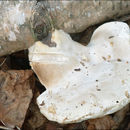tr
kırıntılardaki isimler


Guidance for identification
Tyromyces chioneus, commonly known as the white cheese polypore, is a species of polypore fungus. A widely distributed fungus, it has a circumpolar distribution, in temperate boreal pine forests, of Asia, Europe, and North America, causes white rot in dead hardwood trees, especially birch.
The species was first described as Polyporus chioneus by Elias Fries in 1815. It was transferred to the genus Tyromyces by Petter Karsten in 1881.[1] Tyromyces chioneus is the type species of Tyromyces. The specific epithet chioneus means "snow", referring to its white color. It is commonly known as the "white cheese polypore".[2]
The fruit bodies are semicircular to fan-shaped brackets that measure up to 8 cm (3 in) broad by 10 cm (4 in) wide, with a thickness of 0.5–2 cm (0.2–0.8 in). The upper surface is initially white before aging to yellowish or grayish, and has a texture ranging from smooth to tomentose. The undersurface features white to cream-colored, round to angular pores measuring 3–4 per millimeter. The flesh is soft and fleshy when young, but becomes hard and brittle in age or when dry. It has a mild or indistinct taste, and a pleasant odor.[3]
It has a white spore print, and the spores are smooth, cylindrical, hyaline (translucent), with dimensions of 4–5 by 1.5–2 µm.[2] The basidia are club-shaped, four-spored, and measure 10–15 by 4–5 µm; they have a clamp at their base. The hyphal system is dimitic, consisting of generative and skeletal hyphae. The generative hyphae have clamps and are intricately branched. The skeletal hyphae, in contrast, are thick-walled, rarely branched, and measure 2–4.5 µm in diameter. Although cystidia are absent from the hymenium, there are fused cystidioles (immature cystidia) measuring 15–20 by 4–5 µm.[3]
The species is inedible.[4]
Tyromyces chioneus causes white rot in dead hardwood trees. Its most common host is birch. The species has a circumpolar distribution, in temperate boreal pine forests, including Asia, Europe, and North America.[3] In Greenland, it is common on Betula pubescens.[5]
Cultures of the fungus have been shown to contain a sesquiterpene with anti-HIV activity in laboratory experiments.[6]
Tyromyces chioneus, commonly known as the white cheese polypore, is a species of polypore fungus. A widely distributed fungus, it has a circumpolar distribution, in temperate boreal pine forests, of Asia, Europe, and North America, causes white rot in dead hardwood trees, especially birch.
Tyromyces chioneus (Fr.) P. Karst., Revue mycol., Toulouse 3(9): 17 (1881)[1], è un fungo appartenente alla famiglia Polyporaceae ed è un agente patogeno delle piante. Ricerche scientifiche hanno accertato che questo fungo contiene sesquiterpeni che hanno attività anti-HIV[2]
Fino a 18 cm di diametro, spesso fino a 2 mm, reniforme, convesso o appianato
Bianchi, lunghi 1,5–5 mm.
Biancastri, 3-5 per millimetro, circolari o angolosi.
molle, elastica
Fungo saprofita, fruttifica su tronchi morti di latifoglia, raramente aghifoglia, in primavera-autunno.
Non commestibile.
Tyromyces chioneus (Fr.) P. Karst., Revue mycol., Toulouse 3(9): 17 (1881), è un fungo appartenente alla famiglia Polyporaceae ed è un agente patogeno delle piante. Ricerche scientifiche hanno accertato che questo fungo contiene sesquiterpeni che hanno attività anti-HIV
Cost capìtol a l'é mach në sbòss. Da finì.
A chërs ëdzora al bòsch ëd latifeuje, da ràir ëd conìfere.
![]() A venta mai mangé un bolè trovà se un a l'é nen un bon conossidor dij bolè!
A venta mai mangé un bolè trovà se un a l'é nen un bon conossidor dij bolè!
As peul nen mangesse.
Tyromyces chioneus (Fr.) P. Karst.
Cost capìtol a l'é mach në sbòss. Da finì.
AmbientA chërs ëdzora al bòsch ëd latifeuje, da ràir ëd conìfere.
Comestibilità![]() A venta mai mangé un bolè trovà se un a l'é nen un bon conossidor dij bolè!
A venta mai mangé un bolè trovà se un a l'é nen un bon conossidor dij bolè!
As peul nen mangesse.
Białak śnieżysty (Tyromyces chioneus) (Fr.) P. Karst. – gatunek grzybów z rodziny żagwiowatych (Polyporaceae)[1].
Pozycja w klasyfikacji: Tyromyces, Polyporaceae, Polyporales, Incertae sedis, Agaricomycetes, Agaricomycotina, Basidiomycota, Fungi[1].
Po raz pierwszy został zdiagnozowany przez E. Friesa w 1815 r. jako Polyporus chioneus, do rodzaju Tyromyces przeniósł go Petter Karsten w 1881 r[2]
Synonimów łacińskich ma kilkanaście. Niektóre z nich[2]:
Nazwę polską zaproponował W. Wojewoda w 2003 r. W polskim piśmiennictwie mykologicznym gatunek ten opisywany był przez F. Błońskiego jako żagiew śnieżysta, przez S. Domańskiego jako białak bielutki[3].
Jednoroczne. Kształt półkolisty lub prawie kolisty, czasami resupinowaty, do podłoża przyrośnięty dość słabo. Trzonu brak. Rozmiar: 2-8 × 3-10 cm, grubość 1-3,5 cm. Powierzchnia u młodych owocników omszona i biała, u starszych naga, żółtawa, w końcu szarzejąca. Skórka cienka, daje się odróżnić od miąższu dopiero po wyschnięciu[4].
Rurkowaty. Pory okrągłe lub niemal okrągłe, ale mogą być także wydłużone i labiryntowate. Mają średnicę 0,2—0,3 mm, na jednym mm mieści się ich 3-4[4].
Miękki, nieco ziarnisty, wodnisty, soczysty i dość kruchy. Barwa biała i nie zmienia się po uszkodzeniu. Nie posiada wyraźnego smaku ani zapachu[4]. Po wysuszeniu staje się twardy i kruchy[5].
Wysyp zarodników biały. Zarodniki cylindryczne, nieco wygięte, gładkie, o rozmiarach 4,5 × 1,5-2 μm, nieamyloidalne. Pod wpływem KOH stają się szkliste[6]. Podstawki o rozmiarach 4,5-10 μm. W hymenium brak cystyd, występują jednak niedojrzałe cystydy[5].
Występuje wokółbiegunowo na półkuli północnej, na obszarach o umiarkowanym klimacie w Ameryce Północnej, Azji i w Europie[5]. Rośnie w lasach, na drewnie drzew liściastych, szczególnie na martwych gałęziach drzew, głównie na olszach, brzozie brodawkowatej, grabach, buku i dębach. W Polsce owocniki wytwarza od lipca do września[3].
Grzyb niejadalny. Saprotrof wywołujący białą zgniliznę drewna[4]. W badaniach laboratoryjnych stwierdzono występowanie substancji chemicznych hamujących rozwój wirusa HIV[7]
Białak śnieżysty (Tyromyces chioneus) (Fr.) P. Karst. – gatunek grzybów z rodziny żagwiowatych (Polyporaceae).
Tyromyces chioneus là một loại thực vật chứa sesquiterpenes có tác dụng chống HIV[1]
Tyromyces chioneus là một loại thực vật chứa sesquiterpenes có tác dụng chống HIV